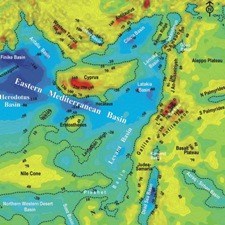Prospecting — the search for valuable reserves such as gold, diamond and natural gas — isn’t just a matter of luck. It’s about knowing where to look. Now researchers at Tel Aviv University have modernized the hit-or-miss search with cutting-edge technology that scans the earth for signs of lucrative resources that could lurk beneath our feet.
Combining a number of surveying techniques for the first time, Prof. Lev Eppelbaum of TAU’s Department of Geophysics and Planetary Sciences at the Raymond and Beverly Sackler Faculty of Exact Sciences and Dr. Youri Katz of TAU’s Department of Zoology at the George S. Wise Faculty of Life Sciences have carried out a more accurate and in-depth land survey of Israel and the surrounding Mediterranean area than ever before. Their findings pinpoint the most likely places to find reservoirs of natural gas and oil.
Fifteen years in the making, their technique, which recently appeared in the journal Positioning, can be applied to any region in the world to more accurately identify possible riches below — before the costs of drilling or mining are incurred.
From buyers to producers
To create detailed structural-tectonic maps of Israel and the surrounding areas, Prof. Eppelbaum and Dr. Katz carried out an integrated survey using a variety of geophysical tools, including advanced analysis of magnetic, gravity, and temperature fields; utilization of seismic, magnetotelluric, and satellite imaging; and numerous well sections and outcropping studies. All of these results were integrated with plate tectonics reconstructions.
Perhaps the most valuable results of their study, the researchers say, are a series of prospective maps which identify specific areas where geological-geophysical teams are most likely to be successful in the search for natural gas and oil. Such information is not only of critical economic importance to Israel, but will also diversify oil and gas options for consumers worldwide.
Just off the shore of Haifa, a northern city along Israel’s coastline, there is believed to be a five hundred billion cubic meter area of gas reserve, Prof. Eppelbaum says. The survey indicates that a few tens of kilometers away, there may be another reserve that would significantly increase the current estimated amount of gas, he notes.
His predictions for additional oil reserves in deep water zones increase the estimated total of gas reserves by 200-300%. “Israel could have a future as a gas country — one that can produce oil and gas and sell it to the rest of the world,” Prof. Eppelbaum predicts.
A well-rounded approach
Prof. Eppelbaum says that the research was inspired by Prof. Zvi Ben-Avraham of the Department of Geophysics and Planetary Sciences, who was the first to apply the theory of plate tectonics to Israel and the Eastern Mediterranean. His findings provide a deeper understanding of the geophysical conditions in the region.
Warning that many researchers specialize too narrowly in a specific field or method, Prof. Eppelbaum stresses that the interdisciplinary approach of the Tel Aviv University team had a direct impact on the success of the study. An integrated approach puts critical information firmly in the grasp of today’s scientists — and those “prospecting” for a brighter tomorrow.


